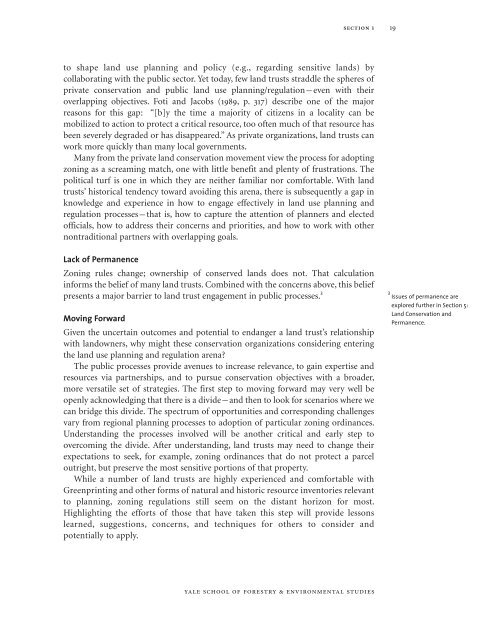Complete Report - Yale University
Complete Report - Yale University
Complete Report - Yale University
Create successful ePaper yourself
Turn your PDF publications into a flip-book with our unique Google optimized e-Paper software.
SECTION 119to shape land use planning and policy (e.g., regarding sensitive lands) bycollaborating with the public sector. Yet today, few land trusts straddle the spheres ofprivate conservation and public land use planning/regulation—even with theiroverlapping objectives. Foti and Jacobs (1989, p. 317) describe one of the majorreasons for this gap: “[b]y the time a majority of citizens in a locality can bemobilized to action to protect a critical resource, too often much of that resource hasbeen severely degraded or has disappeared.” As private organizations, land trusts canwork more quickly than many local governments.Many from the private land conservation movement view the process for adoptingzoning as a screaming match, one with little benefit and plenty of frustrations. Thepolitical turf is one in which they are neither familiar nor comfortable. With landtrusts’ historical tendency toward avoiding this arena, there is subsequently a gap inknowledge and experience in how to engage effectively in land use planning andregulation processes—that is, how to capture the attention of planners and electedofficials, how to address their concerns and priorities, and how to work with othernontraditional partners with overlapping goals.Lack of PermanenceZoning rules change; ownership of conserved lands does not. That calculationinforms the belief of many land trusts. Combined with the concerns above, this beliefpresents a major barrier to land trust engagement in public processes. 3Moving ForwardGiven the uncertain outcomes and potential to endanger a land trust’s relationshipwith landowners, why might these conservation organizations considering enteringthe land use planning and regulation arena?The public processes provide avenues to increase relevance, to gain expertise andresources via partnerships, and to pursue conservation objectives with a broader,more versatile set of strategies. The first step to moving forward may very well beopenly acknowledging that there is a divide—and then to look for scenarios where wecan bridge this divide. The spectrum of opportunities and corresponding challengesvary from regional planning processes to adoption of particular zoning ordinances.Understanding the processes involved will be another critical and early step toovercoming the divide. After understanding, land trusts may need to change theirexpectations to seek, for example, zoning ordinances that do not protect a parceloutright, but preserve the most sensitive portions of that property.While a number of land trusts are highly experienced and comfortable withGreenprinting and other forms of natural and historic resource inventories relevantto planning, zoning regulations still seem on the distant horizon for most.Highlighting the efforts of those that have taken this step will provide lessonslearned, suggestions, concerns, and techniques for others to consider andpotentially to apply.3 Issues of permanence areexplored further in Section 5:Land Conservation andPermanence.yale school of forestry & environmental studies
















